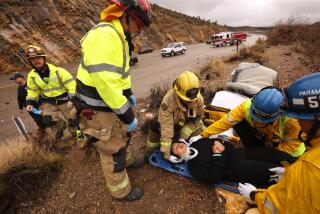Counties Fight to Hang On to EMS Reins
Virginia Price Hastings lives in Upland, where she pays high taxes and expects quick action in case she gets hurt and needs an ambulance to the hospital. She works in Los Angeles and expects the care there to be just as competent. The same goes for all the towns in between.
Because many people regularly travel or work outside the places in which they live, Price Hastings said, it makes sense that California law lets counties--not individual cities--be in charge of coordinating emergency medical service.
Yet Price Hastings, who is director of Los Angeles County’s Emergency Medical Services Division, contends the status quo is under attack by a power-hungry foe bent on wrecking this delicate system.
“They have no business snowing the public,” she said. “They put on their gold braids and their hats and try to intimidate [everybody].”
These opponents, she said, are the local firefighters who are trying to get around a state Supreme Court ruling last year that upheld the counties’ right to dictate emergency medical services.
*
The court ruled against the city of San Bernardino, which had tried to turn its paramedic service over to its own firefighters even though San Bernardino County had a contract with American Medical Response, the world’s biggest private ambulance company.
Because of that ruling, the city of Ventura scrapped its own one-year experiment with providing paramedic services and contracted again with AMR, which services most of the rest of Ventura County.
Last month, state Assemblywoman Deborah Ortiz (D-Sacramento) sponsored a bill to allow cities to run their own paramedic services even if a county EMS contract exists. The bill could come to a vote this fall.
Cities and firefighters back the bill because they are attracted to the insurance reimbursement for taking people to the hospital. Private ambulance companies oppose it because it would cut into their countywide contracts. The issue has triggered bitter power struggles between counties and cities across the state.
“The Ortiz bill is a very dangerous bill,” Price Hastings said. “The county does not support what the fire chiefs are trying to do, and from where I sit, it’s a power play. They do not understand health-care economics.”
Firefighters in such places as the city of Ventura, however, point out that the local firefighter/paramedics cut response times by two minutes and ambulance bills by 40%. They also say private ambulance companies are sometimes too beholden to the bottom line at the expense of quality care.
Others say letting every town go its own way would leave rich cities with good systems and poor ones with bad EMS, fragmenting what already is a very fragmented system, particularly in a place such as Los Angeles County.
Fifty-five of the 88 cities contract for both fire and paramedic service with Los Angeles County, which in turn contracts with private ambulance companies. American Medical Response, which is owned by the big Canadian bus company Laidlaw, has 10 of the 12 ambulance franchises covering those cities.
The 33 cities that do not have contracts with the county have long-standing local arrangements for ambulance service. Burbank and Pasadena, for example, let public paramedics take people to hospitals. Sierra Madre uses its volunteer fire department. The city of Los Angeles provides most paramedic and emergency transportation through its fire department, though it does contract with some private ambulance companies. Glendale uses private ambulances, but city officials are mulling whether to turn the business over to their firefighters.
Despite their differences, all of the county’s 88 cities come under county jurisdiction and must adhere to county standards for response times, training and equipment.
If the Ortiz legislation passes, and when all those private ambulance contracts come up for renewal next year, Los Angeles County is likely to become an intense battleground of competing interests that could have an effect on how fast injured people make it to the hospital--not to mention the size of their ambulance bill.
That charge for services is the one thing that the public and private sector has in common, said Dan Smiley, chief deputy director of the California Emergency Medical Services Authority in Sacramento.
“This is not really a public or private battle,” he said. “What this is are two competing ambulance companies essentially fighting for marketplace dollars. One happens to be owned privately, and one happens to be owned publicly.”
More to Read
Sign up for Essential California
The most important California stories and recommendations in your inbox every morning.
You may occasionally receive promotional content from the Los Angeles Times.










